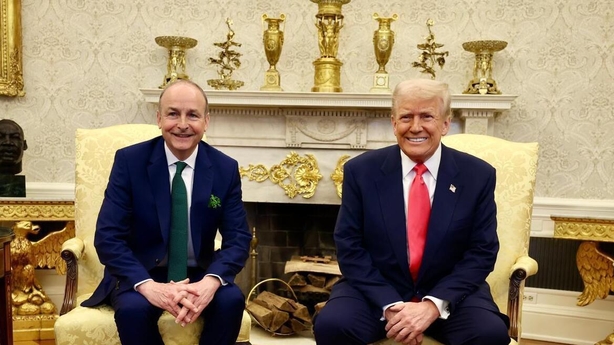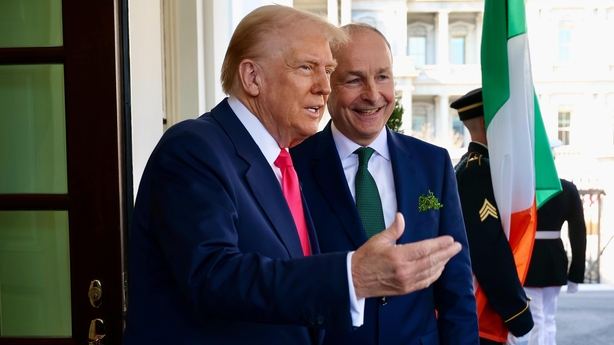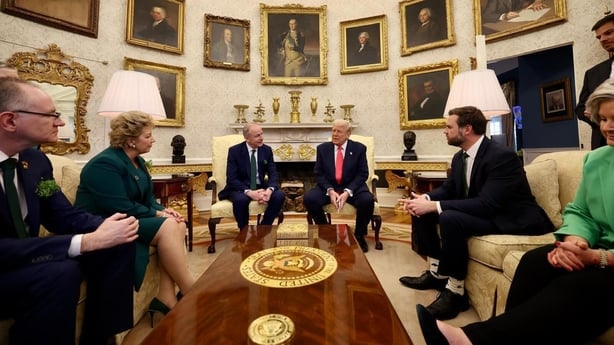The danger isn't past - far from it: there is still going to be a trade war, and Ireland is going to be affected.
President Donald Trump is still going to go after the US pharmaceutical plants in Ireland - the ones that export to the US as well as the EU.
There will also be retaliation for the retaliatory measures brought in by the EU for Mr Trump's steel and aluminum tariffs. That could see US consumers charged more for a range of products such as Irish whiskey (a possible casualty of the EU tariff on US bourbon).
But yesterday’s meeting at the White House between Taoiseach Micheál Martin and President Trump went pretty well. Considering all of the above.
Not to mention the divergent positions the US and Ireland have on Gaza, and the different views on Ukraine on both sides of the Atlantic.
President Trump's Oval Office press conference-cum-bilateral diplomatic engagement with the President of Ukraine showed the perils of this novel format.
Read more: Focus on trade as St Patrick's Day US trip continues
Let it run too long, and simmering tensions can burst out into a full on row in public.
"Great television", Mr Trump called it during that notorious diplomatic train wreck. It was an object lesson in how not to do it. For both sides.
And both sides played their parts.

President Trump did seem to have a genuine soft spot for the Irish.
So whilst he railed about the very large trade surplus Ireland runs with the US - mainly the result of the pharmaceutical industry, much of it US owned but with Irish manufacturing bases (and intellectual property holding companies - but that is service trade, where the US runs a surplus with Ireland) - he did not blame Ireland for making a buck or two by doing what it is doing: He blamed previous US presidents who "allowed" the US companies to do what they are doing.
But there was a "business not personal" tone to the proceedings.
Several times throughout the day the US president spoke fondly of Ireland, and of his golf and hotel resort at Doonbeg, Co Clare.
The Taoiseach leaned into the golf stuff - keeping the conversation on safe ground.
Conor McGregor is apparently the President’s favourite Irish man - he likes the tattoos and his fighting spirit, which led Mr Trump to speak admiringly of the Taoiseach's father who was a noted boxer back in the day.
Read more:
When Martin met Trump - 5 takeaways from their meeting
Trump does not want 'to do anything to hurt Ireland'
And the president's recent round of golf with Rory McIlroy, was another Irish friendly memory. More ice broken, more reasons to like this Irish guy he has to do business with. And being liked by Mr Trump is a better place to be than being disliked by Mr Trump.
Wisely the Taoiseach let the president do most of the talking, and did not really contradict him, even when he went well off track (especially about the EU).
Instead, the tactic was to be on his side or at least emphasise the common ground, not the differences.
When a reporter asked Mr Trump if he thought some of the Northern Ireland political parties were wrong to boycott the events, Mr Trump said he did not know anything about the issue.
Before any back and forth developed with the reporters about Northern Ireland, the Taoiseach intervened and spoke about the president's leadership in peace talks, and how outside initiatives were helpful in the Northern Ireland peace process, and how important it was to stop the killing - echoing Mr Trump's lines about the reasons to push for ceasefires in Gaza and Ukraine.
The president nodded in agreement; hard to argue against your own words.
The effect was to diffuse a potentially difficult situation before it arose.
The Irish objective was not to allow any foreign policy issues get in the way of, or derail, the main business, which was trying to protect the Irish economy and the jobs and Government revenues that rely on it.
Given the US president's stated intention to impose reciprocal tariffs on all imports from 2 April, there is plenty that needs protecting.
Did he succeed? Time will tell.

Mr Trump gave away nothing in public - except some goodwill towards Ireland. And that is not to be discounted going into what could become a very difficult process of negotiations, most of which will be led by the EU, just as it was during the Brexit crisis.
So this is Donald Trump's dilemma, he likes Ireland but hates the big goods trade surplus it has. But by playing up the positive feelings that Mr Trump has, the Taoiseach probably made it a little easier to at least talk in a civilised manner, explain the differences of data and interpretation that can appear stark, but which taken in totality are more explicable, and hopefully easier to bridge.
Another of the Taoiseach's few interventions in the Oval Office involved setting out the economic case for Ireland as a big investor in the US, a big employer in the US and a big buyer of US products - Boeing aircraft were the chosen vehicle (no pun intended).
The Taoiseach spoke of Ryanair and AerCap leasing being, between them, one of the biggest buyers of US-made aircraft, but these purchases are not captured in the US version of the goods trade because they are categorised as financial services (leasing) and not sales of physical goods.
Mr Trump nodded along, seemingly interested in hearing of successful businesses that buy in from the US.
He still wants to win on trade, but you get the impression that he also has a sneaking regard for successful companies no matter where they are from, once they are spending money in the US.
He did not let up.
He kept on about Ireland's massive surplus - other countries as well - but did say "we want to even things up as nicely as we can".
He also said "we don't want to hurt or damage Ireland".
In the context of what he has said about Canada in particular, but also Mexico in recent weeks, that has got to count as a positive result from the meeting: A determination to fix what he sees as a big problem, but a desire to do it in a nice way.
That apparent outcome, that tone from the US president and indeed the entire tone of the day's event suggest a very well prepared meeting, due in no small part to Ireland's Ambassador to the US Geraldine Byrne Nason.
She has deep contacts in the White House and the wider Republican Party (she enjoyed some top-tier access at the Republican National convention in Chicago last July, for example).
For much of the past two months there was doubt in Ireland that there would even be an invitation to the White House for a bilateral.
But the rapid standing up of a full day of events - the Oval Office, the Speaker's lunch, the Shamrock Bowl reception in the White House ballroom in the evening, indicate a positive disposition towards Ireland - as long as it is willing to talk business and do deals.
Which is better than being openly attacked and expected to do deals.

The Ambassador, the Secretary General of the Government and the Taoiseach's Chief of Staff were all on the sofa to the Taoiseach’s left during the meeting, opposite Vice President JD Vance and Mr Trump’s powerful Chief of Staff (and election supremo) Susie Wiles.
Any dispute was kept behind closed doors, but if the plan was to get in and out of the White House with as little damage as possible, then the plan seems to have worked, at least for now.
It is a good base to be starting from.
Getting to that base, not fighting with the US President, not "taking him on" about Gaza may not have played well among some sections of the home audience.
But from the Government’s point of view, the most important audience yesterday was an audience of one, and he was sitting right beside the Taoiseach.






